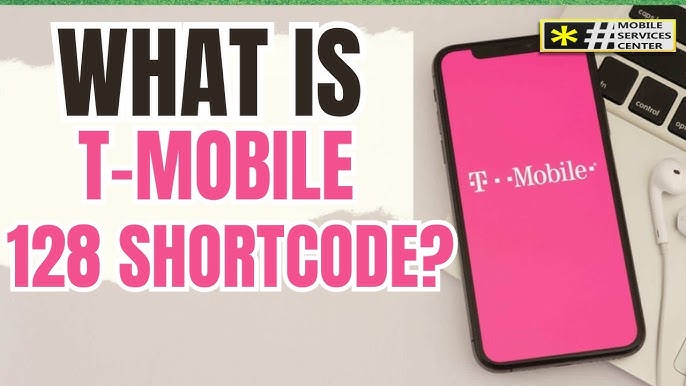If you have scrolled through your T-Mobile call and text usage history, you may have noticed a log entry for an incoming text message from the abbreviated number 128. This mysterious 128 incoming text message is not a message from a person, a scam, or a marketing company; it is a system-level short code used by T-Mobile to log specific, behind-the-scenes network activities, primarily related to your voicemail and connected devices.
This article will demystify the T-Mobile short code 128, explain why it appears on your account history, and clarify the harmless, common actions that trigger this system notification.

Decoding the T-Mobile Short Code 128
Short codes are typically 5- or 6-digit numbers used by businesses or carriers for high-volume, automated messaging (like two-factor authentication or promotional alerts). The code 128 is unusual because it doesn’t function like a traditional, customer-facing short code.
The 128 short code is best understood as an internal routing number or placeholder used by T-Mobile’s system to track events that look like an incoming message to the billing system, even though they don’t produce a visible text alert on your phone.
The Most Common Triggers for the “128” Code
Based on extensive customer reports and carrier representative explanations, the vast majority of log entries from the 128 incoming text message short code are triggered by two routine, non-alarming actions:
- Voicemail Notifications
The single most frequent reason you see the 128 short code is when your phone receives a voicemail notification.
- When someone leaves a message, the T-Mobile network sends a system alert to your device to trigger the little voicemail icon and banner notification.
- This internal network communication is logged on your account history as an “incoming text” from the system code 128.
- Similarly, calling your voicemail to retrieve messages can also sometimes create a log entry from this code.
- Connected Device Syncing (Apple Watch/Tablet)
If you have a primary smartphone line paired with a connected device on the same T-Mobile account (such as an Apple Watch, a cellular-enabled tablet, or a secondary phone):
- The system uses the 128 short code to log the background communication required to keep the devices synchronized.
- For Apple Watch users, in particular, the 128 text message may appear in your usage history every time your watch receives a notification or performs a sync action. This is the system recording that the registered device received information, even if it’s not a standard text message.
Is the 128 Short Code a Scam?
No. The 128 short code is not an indicator of a scam, a hidden charge, or an unwanted premium subscription.
Because it is an internal T-Mobile system code, you can simply ignore it. You will never receive a text message from 128 asking you to click a link, provide personal information, or pay money.
T-Mobile Short Codes for Customer Self-Service
While 128 is an internal reporting code, T-Mobile does utilize several other short codes that customers can text or dial to access useful self-service features. Unlike 128, these codes require you to initiate the communication.
| Short Code | What to Dial/Text | Function |
| #BAL# | #225# | Check your account balance and last payment. |
| #NUM# | #686# | Display your own phone number on the screen. |
| #MIN# | #646# | Check your minute usage (for older/non-unlimited plans). |
| #WEB# | #932# | Check your data usage, plan details, and data expiration date. |
| 7726 | (S P A M) | Forward suspicious spam text messages to report them to T-Mobile. |
Frequently Asked Questions
Why do I see a 128 incoming text message, but I don’t have a voicemail?
It is possible for the system notification to be sent even if the caller hangs up before leaving a message, or if a network event is logged internally but doesn’t fully trigger the visual voicemail icon on your device. The code simply logs the attempted or network-internal communication. If you see it, it is generally harmless and simply a sign of normal network activity.
How do I block the 128 incoming text message?
You cannot directly block the 128 short code because it is a fundamental part of how the T-Mobile network delivers system alerts, particularly for voicemail and connected devices. Since it is only a log entry and does not produce a notification on your phone, there is no action needed. Attempting to block it might inadvertently disable important system functions.
How do I stop unwanted commercial short code texts on T-Mobile?
For legitimate marketing or transactional short codes (like those from a bank or retailer), the easiest way to stop receiving them is to reply to the text message with one of the universal opt-out commands, as required by law:
- STOP
- END
- CANCEL
- UNSUBSCRIBE
- QUIT
If you are dealing with a malicious or fraudulent text, do not reply. Instead, forward the suspicious message to the short code 7726 (SPAM).
Is T-Mobile Short Code 128 a premium-rate number with extra charges?
No. The T-Mobile short code 128 is an internal, informational code. There are no associated per-message charges or subscription fees for the log entries you see from this number.
Conclusion
The 128 incoming text message on T-Mobile is nothing to worry about. It is a harmless system-level short code used to log background carrier activity on your account, most commonly when your phone receives a voicemail notification or when a paired device like an Apple Watch performs a syncing action.
You can rest assured that this entry is not a sign of a scam or a mysterious subscription. It’s simply a technical detail of your T-Mobile service working in the background to keep your communication services running smoothly.


